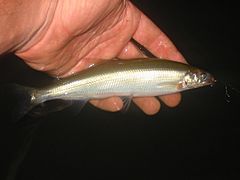Australian Grayling
| Australian grayling | |
|---|---|
 |
|
| A relatively small Australian grayling caught and released on a dry fly. | |
| Scientific classification | |
| Kingdom: | Animalia |
| Phylum: | Chordata |
| Class: | Actinopterygii |
| Order: | Osmeriformes |
| Family: | Retropinnidae |
| Genus: | Prototroctes |
| Species: | P. maraena |
| Binomial name | |
|
Prototroctes maraena Günther, 1864 |
|
The Australian grayling (Prototroctes maraena) is a primarily freshwater fish found in coastal rivers in south-eastern mainland Australia and Tasmania. In past decades it has also been known as the “cucumber mullet” or “cucumber herring,” for its cucumber-like odor.
The Australian grayling is a streamlined fish with a long and slender body and small conical head. Colouration is usually silver on the flanks and dusky olive on the back, overlain with a gold sheen.
Australian grayling commonly live for 2–3 years and reach around 20 cm in length, although rare individuals have been recorded up to 5 years in age and 33 cm in length. The fish has an omnivorous diet, feeding upon algae, shrimp, and small insects. They have specially adapted teeth and a long gut to help with the digestion of algae.
Australian grayling spawn in the freshwater reaches of coastal rivers. Spawning is thought to occur in late autumn or early winter. McDowall (1996) reports that egg counts range from 25,000 to 67,000 in females 170–200 mm long, and that the small (~1 mm) demersal eggs probably settle among gravel and cobble in the river bed before hatching. Hatched larvae are washed out to sea. Australian grayling juveniles return to the freshwater reaches of rivers after roughly 6 months at sea and spend the rest of their lives in river habitats.
Before the introduction of exotic fish species including the Eastern mosquitofish and trout to Australian waterways the Australian grayling and spotted galaxias were keenly fished by recreational anglers using fly-fishing gear. The species was appreciated for its willingness to take wet and dry flies, its excellent fighting ability on very light tackle, and its relatively large size. However, due to declining numbers the fish is now protected under the Environment Protection and Biodiversity Conservation Act 1999. Heavy penalties apply for taking any of the fish.
Australian grayling suffered massive initial declines in 1869–70 by very large, unexplained fish kills (Saville-Kent, 1888). Descriptions of grayling killed in this event of being covered in "cottony growths" suggests a fungal pathogen, possibly marking the arrival of exotic Saprolegnia fungus into Australian freshwater habitats thanks to the reckless importation of exotic salmonid species.
...
Wikipedia

